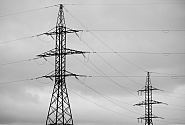
On Thursday, 21 March, the Saeima in the third and final reading adopted amendments to the Energy Law aimed to facilitate the installation of high-voltage external engineering networks, by simplifying procedures to coordinate the rebuilding with the owners of the affected land.
The amendments provide for the right of an energy supply company to replace the procedure for coordination of the construction (installation) of a new unit with notifying the land owner or lawful possessor. This is the case where a unit, such as a high-voltage line, is installed next to a unit that is marked for full or partial demolition within the protection zone of the existing unit.
The authors of the draft law at the Ministry of Economics indicate that high-voltage networks ensure the supply of electricity for important needs of the state and society. Until now, it has been difficult to develop external engineering networks for energy supply, as their installation had to be coordinated with all owners of the affected land. Coordination requirement also applied to cases where the old engineering network is dismantled and replaced by a new one. In practice, landowners impose disproportionate conditions of coordination, which increases the cost of the construction project, as well as the electricity transmission and distribution tariffs, says the explanatory note to the amendments.
In order to ensure uninterrupted energy supply, in most cases it is not possible to disconnect the high-voltage line or substation from the current, the representative of JSC “Augstsprieguma tīkls” previously said to the Economic, Agricultural, Environmental and Regional Policy Committee responsible for the progress of the draft law in the Saeima. Therefore, for example, before the old high voltage line or substation is dismantled, a new one must be built and connected next to it. It is also essential to ensure high-quality and safe rebuilding of engineering networks, including planned additional capacity.
The amendments state that the position of the protection zone for overhead lines of high voltage networks and underwater lines of high voltage cables may change by no more than 20 per cent in relation to the outer edge of the existing protection zone after the installation of the new unit. In turn, for underground high-voltage electrical network cables – no more than two meters. According to the law, these procedures can only be applied once to change the protection zone.
This means, for example, for a high-voltage line with a capacity of 330 kilovolts, if necessary, the protection zone could change within six metres, previously stated the Ministry of Climate and Energy at the meeting of the responsible Committee.
In response to questions from MPs, the Ministry of Economics also indicated that the owner of the affected land would be entitled to compensation in the event of a change in the location of the protected zone. This is already covered by the existing legal framework.
Amendments will enter into force on the day following their promulgation.
Saeima Press Service







